International Taxation: Analysis of Australian Tax Laws and Cases
VerifiedAdded on 2022/11/28
|6
|1196
|103
Report
AI Summary
This report delves into the intricacies of international taxation, examining the structure and application of tax laws in a global context, particularly focusing on Australia. It addresses key issues such as transfer pricing, where companies manipulate prices in transactions between related entities to minimize tax liabilities, often by channeling profits to tax havens. The report highlights the Base Erosion and Profit Shifting (BEPS) phenomenon and the various strategies employed by multinational corporations to avoid taxes. It explores the legal framework in Australia, including Subdivision 815 of the Income Tax Assessment Act 1997 and the importance of maintaining accurate records. A significant portion of the report is dedicated to the Google Australia case, illustrating how transfer pricing can be used to reduce tax obligations. The analysis includes the application of Australian tax laws to this case and concludes with the need for more stringent tax avoidance rules and regular audits to ensure compliance.
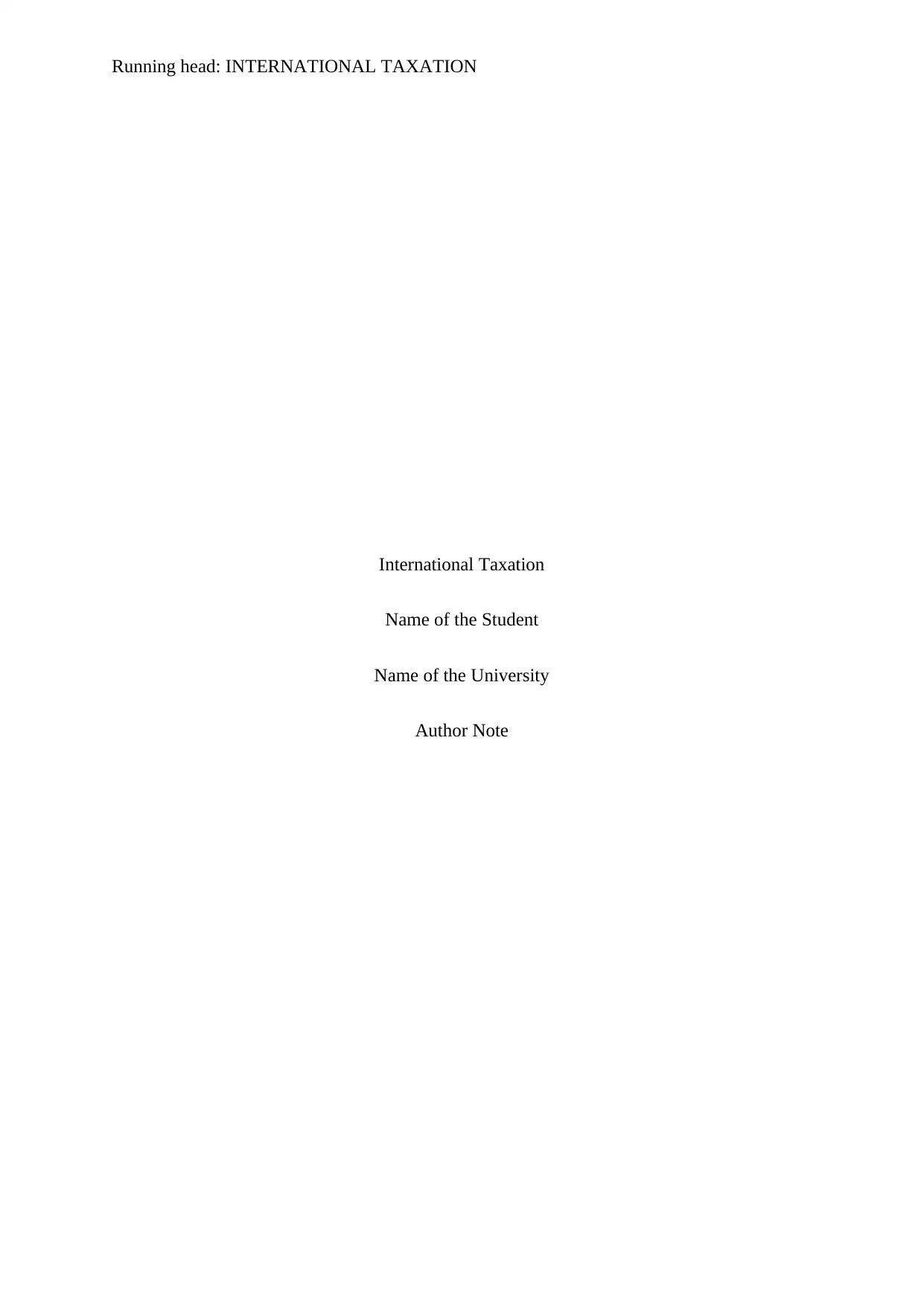
Running head: INTERNATIONAL TAXATION
International Taxation
Name of the Student
Name of the University
Author Note
International Taxation
Name of the Student
Name of the University
Author Note
Paraphrase This Document
Need a fresh take? Get an instant paraphrase of this document with our AI Paraphraser
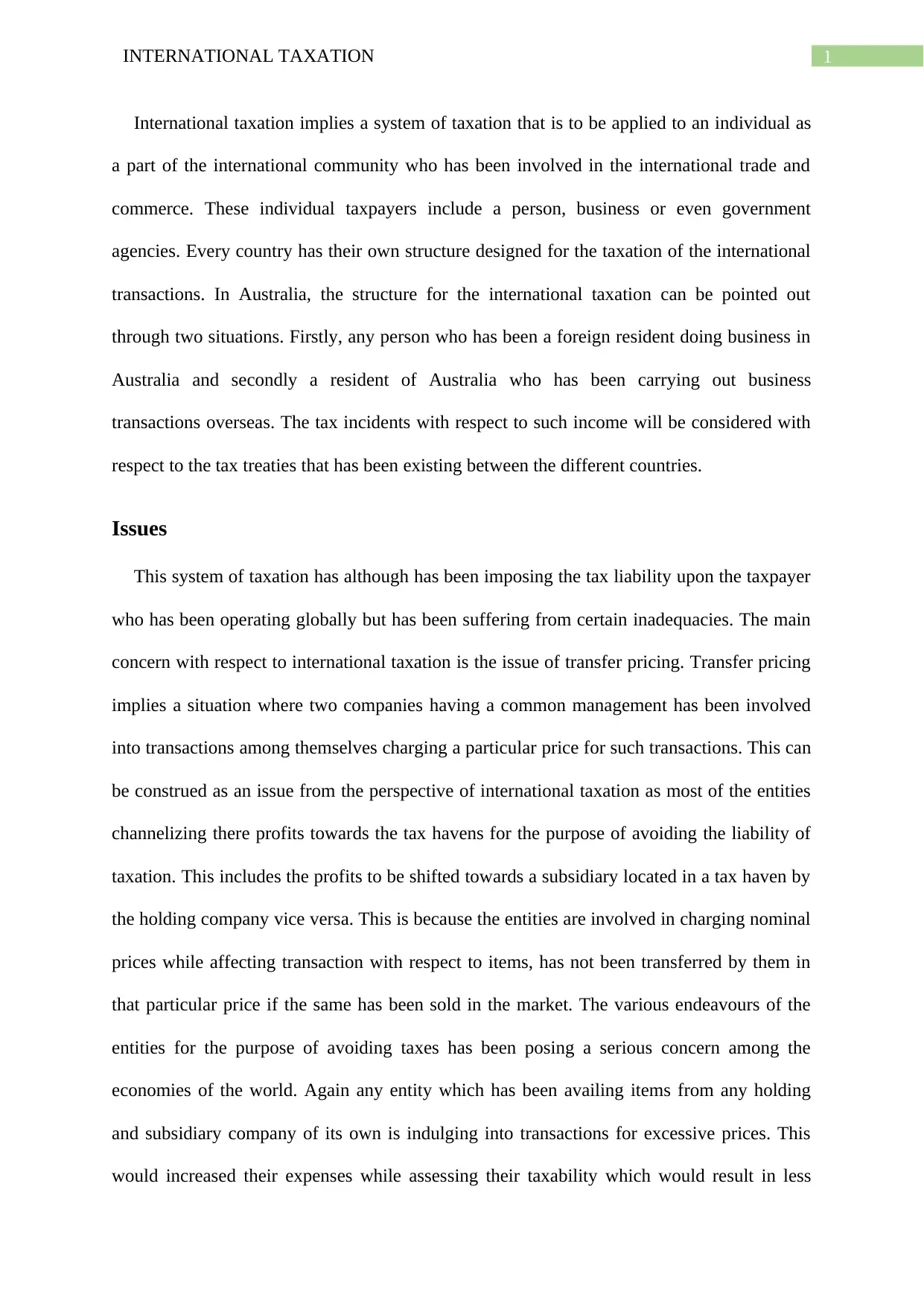
1INTERNATIONAL TAXATION
International taxation implies a system of taxation that is to be applied to an individual as
a part of the international community who has been involved in the international trade and
commerce. These individual taxpayers include a person, business or even government
agencies. Every country has their own structure designed for the taxation of the international
transactions. In Australia, the structure for the international taxation can be pointed out
through two situations. Firstly, any person who has been a foreign resident doing business in
Australia and secondly a resident of Australia who has been carrying out business
transactions overseas. The tax incidents with respect to such income will be considered with
respect to the tax treaties that has been existing between the different countries.
Issues
This system of taxation has although has been imposing the tax liability upon the taxpayer
who has been operating globally but has been suffering from certain inadequacies. The main
concern with respect to international taxation is the issue of transfer pricing. Transfer pricing
implies a situation where two companies having a common management has been involved
into transactions among themselves charging a particular price for such transactions. This can
be construed as an issue from the perspective of international taxation as most of the entities
channelizing there profits towards the tax havens for the purpose of avoiding the liability of
taxation. This includes the profits to be shifted towards a subsidiary located in a tax haven by
the holding company vice versa. This is because the entities are involved in charging nominal
prices while affecting transaction with respect to items, has not been transferred by them in
that particular price if the same has been sold in the market. The various endeavours of the
entities for the purpose of avoiding taxes has been posing a serious concern among the
economies of the world. Again any entity which has been availing items from any holding
and subsidiary company of its own is indulging into transactions for excessive prices. This
would increased their expenses while assessing their taxability which would result in less
International taxation implies a system of taxation that is to be applied to an individual as
a part of the international community who has been involved in the international trade and
commerce. These individual taxpayers include a person, business or even government
agencies. Every country has their own structure designed for the taxation of the international
transactions. In Australia, the structure for the international taxation can be pointed out
through two situations. Firstly, any person who has been a foreign resident doing business in
Australia and secondly a resident of Australia who has been carrying out business
transactions overseas. The tax incidents with respect to such income will be considered with
respect to the tax treaties that has been existing between the different countries.
Issues
This system of taxation has although has been imposing the tax liability upon the taxpayer
who has been operating globally but has been suffering from certain inadequacies. The main
concern with respect to international taxation is the issue of transfer pricing. Transfer pricing
implies a situation where two companies having a common management has been involved
into transactions among themselves charging a particular price for such transactions. This can
be construed as an issue from the perspective of international taxation as most of the entities
channelizing there profits towards the tax havens for the purpose of avoiding the liability of
taxation. This includes the profits to be shifted towards a subsidiary located in a tax haven by
the holding company vice versa. This is because the entities are involved in charging nominal
prices while affecting transaction with respect to items, has not been transferred by them in
that particular price if the same has been sold in the market. The various endeavours of the
entities for the purpose of avoiding taxes has been posing a serious concern among the
economies of the world. Again any entity which has been availing items from any holding
and subsidiary company of its own is indulging into transactions for excessive prices. This
would increased their expenses while assessing their taxability which would result in less
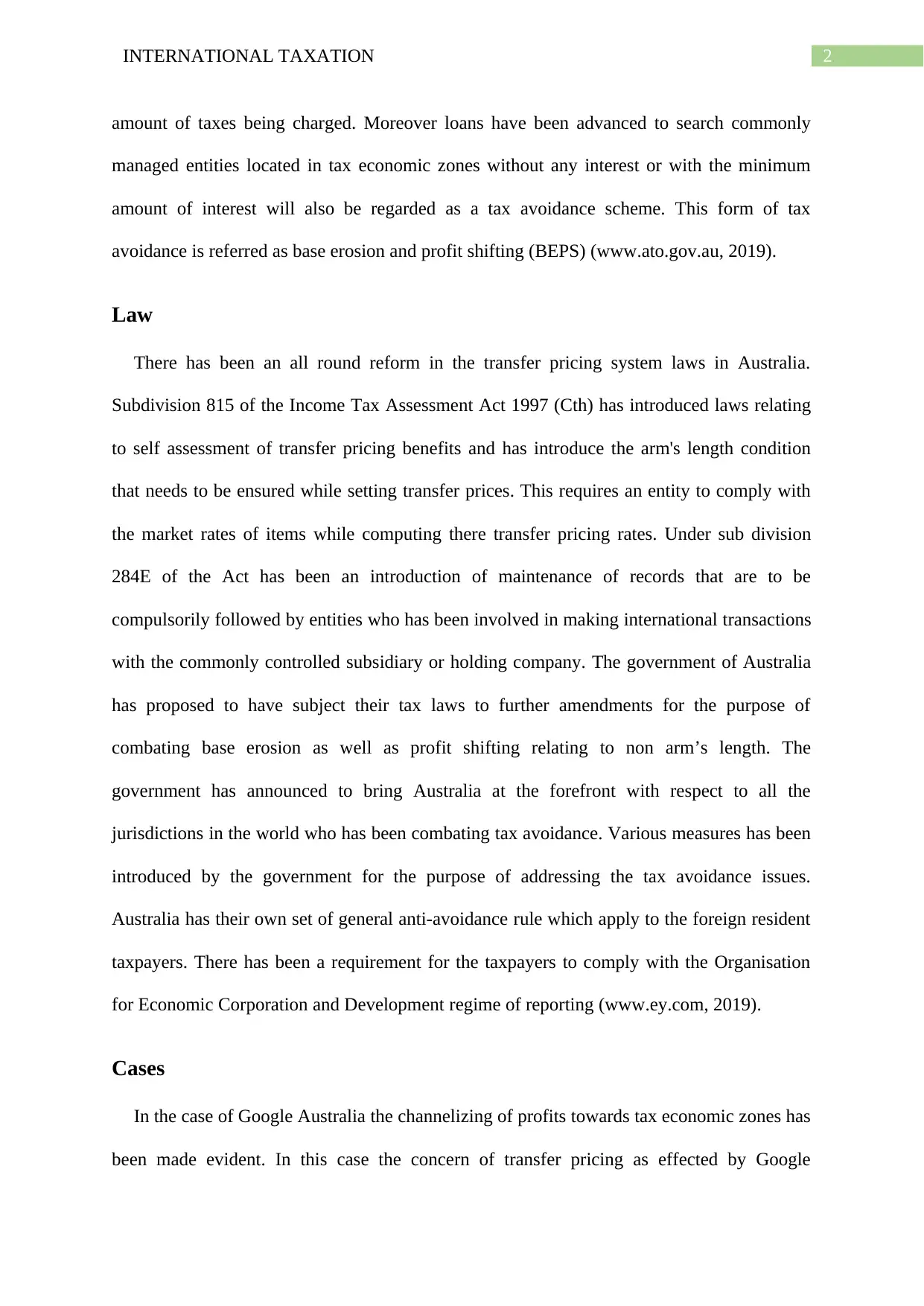
2INTERNATIONAL TAXATION
amount of taxes being charged. Moreover loans have been advanced to search commonly
managed entities located in tax economic zones without any interest or with the minimum
amount of interest will also be regarded as a tax avoidance scheme. This form of tax
avoidance is referred as base erosion and profit shifting (BEPS) (www.ato.gov.au, 2019).
Law
There has been an all round reform in the transfer pricing system laws in Australia.
Subdivision 815 of the Income Tax Assessment Act 1997 (Cth) has introduced laws relating
to self assessment of transfer pricing benefits and has introduce the arm's length condition
that needs to be ensured while setting transfer prices. This requires an entity to comply with
the market rates of items while computing there transfer pricing rates. Under sub division
284E of the Act has been an introduction of maintenance of records that are to be
compulsorily followed by entities who has been involved in making international transactions
with the commonly controlled subsidiary or holding company. The government of Australia
has proposed to have subject their tax laws to further amendments for the purpose of
combating base erosion as well as profit shifting relating to non arm’s length. The
government has announced to bring Australia at the forefront with respect to all the
jurisdictions in the world who has been combating tax avoidance. Various measures has been
introduced by the government for the purpose of addressing the tax avoidance issues.
Australia has their own set of general anti-avoidance rule which apply to the foreign resident
taxpayers. There has been a requirement for the taxpayers to comply with the Organisation
for Economic Corporation and Development regime of reporting (www.ey.com, 2019).
Cases
In the case of Google Australia the channelizing of profits towards tax economic zones has
been made evident. In this case the concern of transfer pricing as effected by Google
amount of taxes being charged. Moreover loans have been advanced to search commonly
managed entities located in tax economic zones without any interest or with the minimum
amount of interest will also be regarded as a tax avoidance scheme. This form of tax
avoidance is referred as base erosion and profit shifting (BEPS) (www.ato.gov.au, 2019).
Law
There has been an all round reform in the transfer pricing system laws in Australia.
Subdivision 815 of the Income Tax Assessment Act 1997 (Cth) has introduced laws relating
to self assessment of transfer pricing benefits and has introduce the arm's length condition
that needs to be ensured while setting transfer prices. This requires an entity to comply with
the market rates of items while computing there transfer pricing rates. Under sub division
284E of the Act has been an introduction of maintenance of records that are to be
compulsorily followed by entities who has been involved in making international transactions
with the commonly controlled subsidiary or holding company. The government of Australia
has proposed to have subject their tax laws to further amendments for the purpose of
combating base erosion as well as profit shifting relating to non arm’s length. The
government has announced to bring Australia at the forefront with respect to all the
jurisdictions in the world who has been combating tax avoidance. Various measures has been
introduced by the government for the purpose of addressing the tax avoidance issues.
Australia has their own set of general anti-avoidance rule which apply to the foreign resident
taxpayers. There has been a requirement for the taxpayers to comply with the Organisation
for Economic Corporation and Development regime of reporting (www.ey.com, 2019).
Cases
In the case of Google Australia the channelizing of profits towards tax economic zones has
been made evident. In this case the concern of transfer pricing as effected by Google
⊘ This is a preview!⊘
Do you want full access?
Subscribe today to unlock all pages.

Trusted by 1+ million students worldwide
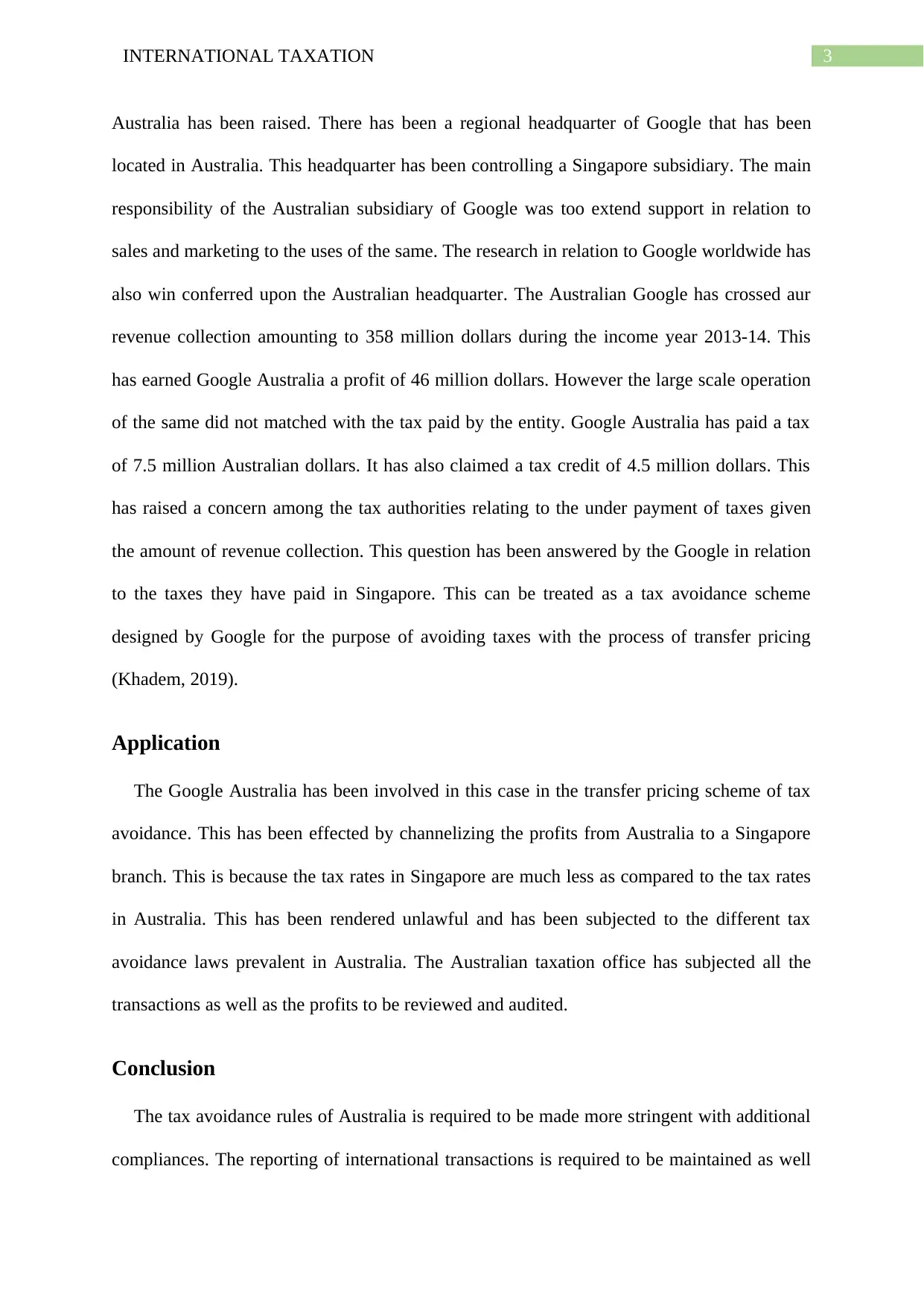
3INTERNATIONAL TAXATION
Australia has been raised. There has been a regional headquarter of Google that has been
located in Australia. This headquarter has been controlling a Singapore subsidiary. The main
responsibility of the Australian subsidiary of Google was too extend support in relation to
sales and marketing to the uses of the same. The research in relation to Google worldwide has
also win conferred upon the Australian headquarter. The Australian Google has crossed aur
revenue collection amounting to 358 million dollars during the income year 2013-14. This
has earned Google Australia a profit of 46 million dollars. However the large scale operation
of the same did not matched with the tax paid by the entity. Google Australia has paid a tax
of 7.5 million Australian dollars. It has also claimed a tax credit of 4.5 million dollars. This
has raised a concern among the tax authorities relating to the under payment of taxes given
the amount of revenue collection. This question has been answered by the Google in relation
to the taxes they have paid in Singapore. This can be treated as a tax avoidance scheme
designed by Google for the purpose of avoiding taxes with the process of transfer pricing
(Khadem, 2019).
Application
The Google Australia has been involved in this case in the transfer pricing scheme of tax
avoidance. This has been effected by channelizing the profits from Australia to a Singapore
branch. This is because the tax rates in Singapore are much less as compared to the tax rates
in Australia. This has been rendered unlawful and has been subjected to the different tax
avoidance laws prevalent in Australia. The Australian taxation office has subjected all the
transactions as well as the profits to be reviewed and audited.
Conclusion
The tax avoidance rules of Australia is required to be made more stringent with additional
compliances. The reporting of international transactions is required to be maintained as well
Australia has been raised. There has been a regional headquarter of Google that has been
located in Australia. This headquarter has been controlling a Singapore subsidiary. The main
responsibility of the Australian subsidiary of Google was too extend support in relation to
sales and marketing to the uses of the same. The research in relation to Google worldwide has
also win conferred upon the Australian headquarter. The Australian Google has crossed aur
revenue collection amounting to 358 million dollars during the income year 2013-14. This
has earned Google Australia a profit of 46 million dollars. However the large scale operation
of the same did not matched with the tax paid by the entity. Google Australia has paid a tax
of 7.5 million Australian dollars. It has also claimed a tax credit of 4.5 million dollars. This
has raised a concern among the tax authorities relating to the under payment of taxes given
the amount of revenue collection. This question has been answered by the Google in relation
to the taxes they have paid in Singapore. This can be treated as a tax avoidance scheme
designed by Google for the purpose of avoiding taxes with the process of transfer pricing
(Khadem, 2019).
Application
The Google Australia has been involved in this case in the transfer pricing scheme of tax
avoidance. This has been effected by channelizing the profits from Australia to a Singapore
branch. This is because the tax rates in Singapore are much less as compared to the tax rates
in Australia. This has been rendered unlawful and has been subjected to the different tax
avoidance laws prevalent in Australia. The Australian taxation office has subjected all the
transactions as well as the profits to be reviewed and audited.
Conclusion
The tax avoidance rules of Australia is required to be made more stringent with additional
compliances. The reporting of international transactions is required to be maintained as well
Paraphrase This Document
Need a fresh take? Get an instant paraphrase of this document with our AI Paraphraser

4INTERNATIONAL TAXATION
as the records needs to be furnished on a regular basis. A quarterly audit of such transactions
is required to be effected by the tax authorities.
as the records needs to be furnished on a regular basis. A quarterly audit of such transactions
is required to be effected by the tax authorities.
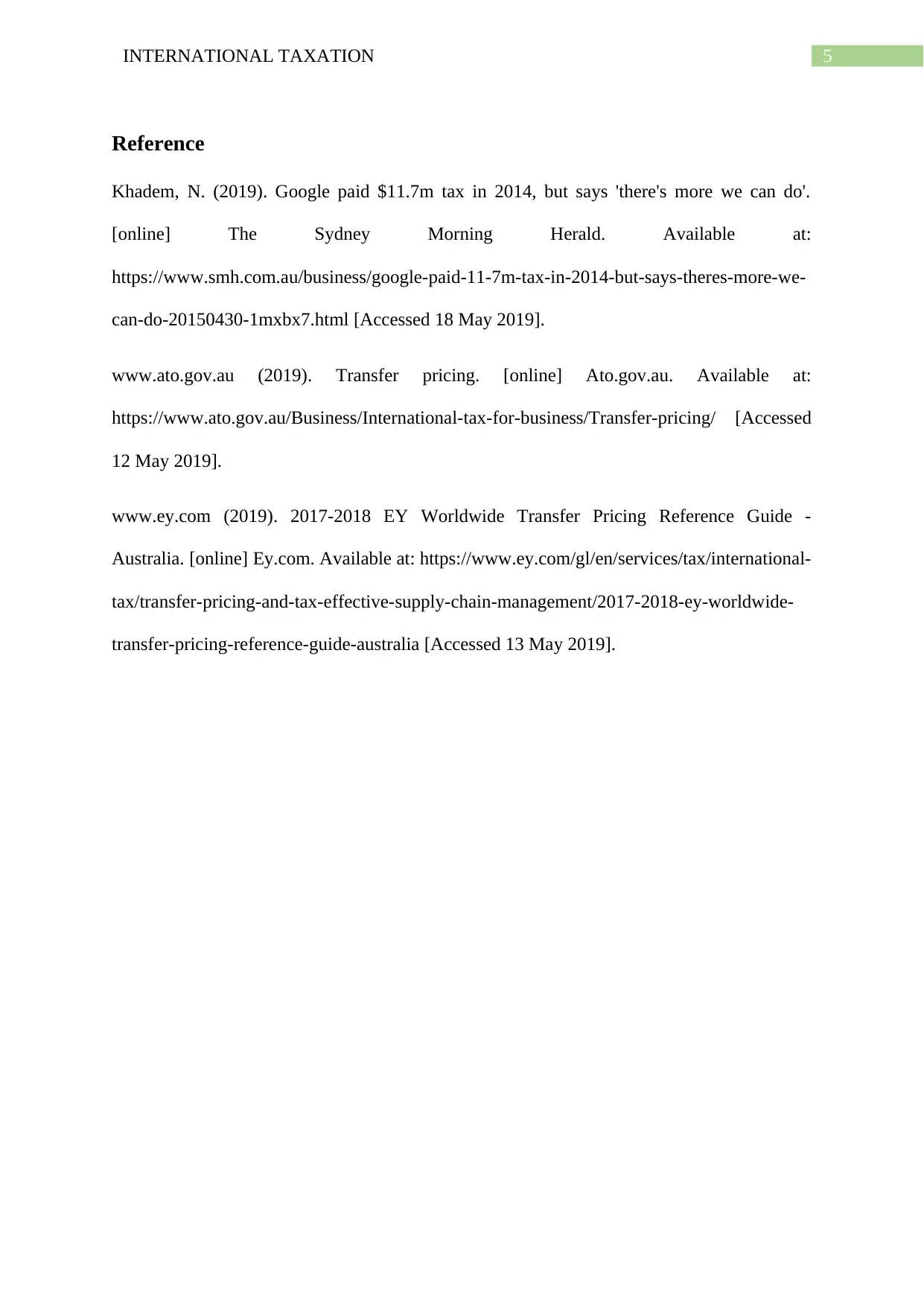
5INTERNATIONAL TAXATION
Reference
Khadem, N. (2019). Google paid $11.7m tax in 2014, but says 'there's more we can do'.
[online] The Sydney Morning Herald. Available at:
https://www.smh.com.au/business/google-paid-11-7m-tax-in-2014-but-says-theres-more-we-
can-do-20150430-1mxbx7.html [Accessed 18 May 2019].
www.ato.gov.au (2019). Transfer pricing. [online] Ato.gov.au. Available at:
https://www.ato.gov.au/Business/International-tax-for-business/Transfer-pricing/ [Accessed
12 May 2019].
www.ey.com (2019). 2017-2018 EY Worldwide Transfer Pricing Reference Guide -
Australia. [online] Ey.com. Available at: https://www.ey.com/gl/en/services/tax/international-
tax/transfer-pricing-and-tax-effective-supply-chain-management/2017-2018-ey-worldwide-
transfer-pricing-reference-guide-australia [Accessed 13 May 2019].
Reference
Khadem, N. (2019). Google paid $11.7m tax in 2014, but says 'there's more we can do'.
[online] The Sydney Morning Herald. Available at:
https://www.smh.com.au/business/google-paid-11-7m-tax-in-2014-but-says-theres-more-we-
can-do-20150430-1mxbx7.html [Accessed 18 May 2019].
www.ato.gov.au (2019). Transfer pricing. [online] Ato.gov.au. Available at:
https://www.ato.gov.au/Business/International-tax-for-business/Transfer-pricing/ [Accessed
12 May 2019].
www.ey.com (2019). 2017-2018 EY Worldwide Transfer Pricing Reference Guide -
Australia. [online] Ey.com. Available at: https://www.ey.com/gl/en/services/tax/international-
tax/transfer-pricing-and-tax-effective-supply-chain-management/2017-2018-ey-worldwide-
transfer-pricing-reference-guide-australia [Accessed 13 May 2019].
⊘ This is a preview!⊘
Do you want full access?
Subscribe today to unlock all pages.

Trusted by 1+ million students worldwide
1 out of 6
Related Documents
Your All-in-One AI-Powered Toolkit for Academic Success.
+13062052269
info@desklib.com
Available 24*7 on WhatsApp / Email
![[object Object]](/_next/static/media/star-bottom.7253800d.svg)
Unlock your academic potential
Copyright © 2020–2025 A2Z Services. All Rights Reserved. Developed and managed by ZUCOL.





